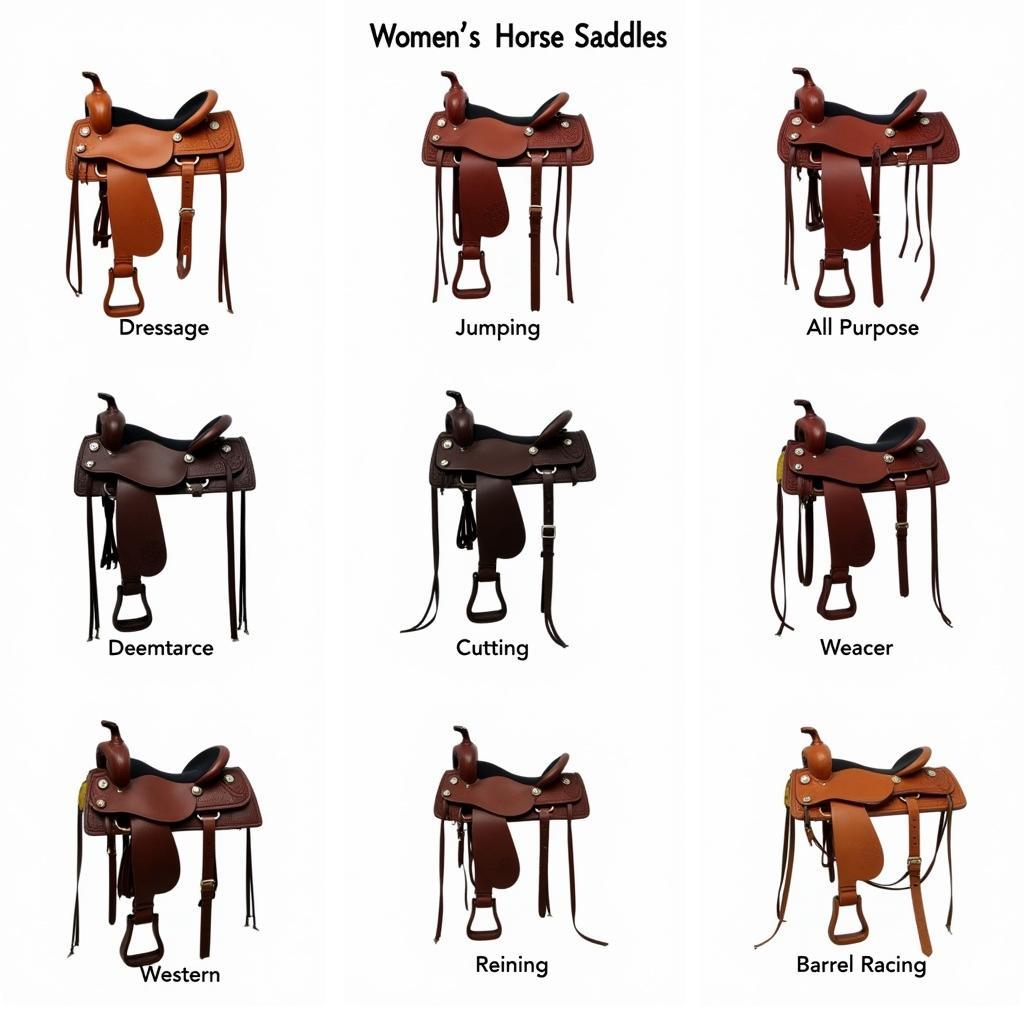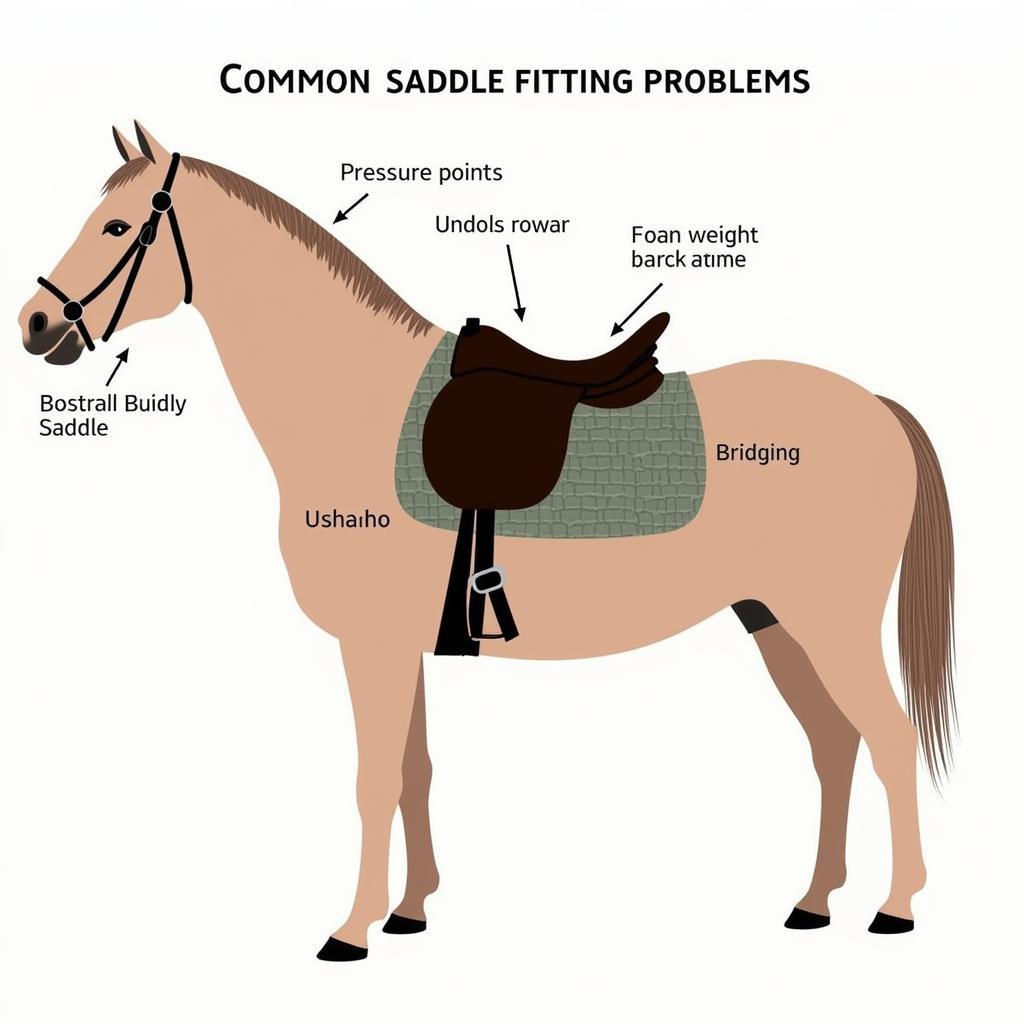Women’s horse saddles are designed with the unique needs of female riders in mind. From ensuring comfort and stability to enhancing performance and promoting proper posture, choosing the right saddle is crucial for both horse and rider. This guide will delve into the key features of women’s saddles, helping you make an informed decision that will elevate your riding experience. Learn how to select the perfect saddle based on your discipline, body type, and the conformation of your horse.
Key Considerations When Choosing Women’s Horse Saddles
Finding the right saddle can be a daunting task, but with a little knowledge and guidance, you can pinpoint the perfect one. First, consider your riding discipline. Are you a Western rider, an English rider, or perhaps something else entirely? The discipline will dictate the general style and design of your saddle. English saddles are typically lighter and more streamlined, designed for disciplines like dressage and jumping. Western saddles, on the other hand, are heavier and feature a deeper seat and a prominent horn, ideal for ranch work and trail riding. Within each discipline, there are further specializations. For example, a dressage saddle will differ significantly from a jumping saddle. After you’ve settled on the discipline, consider the unique needs of your body.
If you’re new to riding, visiting a horse saddle seat specialist or experienced saddler can be invaluable. They can help you understand the nuances of saddle fit and guide you toward appropriate options. They’ll assess your riding style, body shape, and the conformation of your horse to recommend a saddle that optimizes comfort and performance.
Understanding Saddle Fit for Both Horse and Rider
A well-fitted saddle is paramount for both your comfort and your horse’s well-being. For the rider, a proper fit ensures a balanced and secure seat, preventing discomfort and potential injuries. For the horse, it distributes the rider’s weight evenly, preventing pressure points and allowing for freedom of movement. A poorly fitted saddle can lead to back pain, muscle soreness, and even behavioral issues in horses.
Consider factors like seat size, flap length, and tree width when assessing saddle fit. The seat size should accommodate your body comfortably, allowing for proper leg position and balance. Flap length should be appropriate for your leg length, ensuring that your knee falls naturally in the sweet spot of the saddle. The tree width, the internal frame of the saddle, must conform to your horse’s back to avoid pinching or bridging.
Exploring Different Types of Women’s Horse Saddles
Women’s horse saddles come in a wide variety of styles, each tailored to specific disciplines and preferences. Within the English riding world, you’ll find saddles designed for dressage, jumping, all-purpose riding, and more. Western saddles also have their own variations, such as cutting saddles, reining saddles, and barrel racing saddles. Understanding the differences between these saddle types is key to selecting the right one for your riding goals. Some women prefer saddles with a deeper seat for added security, while others opt for a flatter seat that allows for greater freedom of movement.
 Different Types of Women's Horse Saddles
Different Types of Women's Horse Saddles
“A properly fitted saddle can significantly improve a rider’s performance and enhance their connection with the horse,” says renowned equine expert Dr. Emily Carter. “It’s an investment that pays dividends in comfort, safety, and overall riding enjoyment.”
Caring for Your Women’s Horse Saddle
Maintaining your saddle is essential to prolong its lifespan and preserve its quality. Regular cleaning with appropriate saddle soap and conditioner will keep the leather supple and prevent cracking. Storing your saddle in a cool, dry place away from direct sunlight will also help protect it from damage.
A well-maintained saddle not only looks good but also performs better. It provides a comfortable and secure seat for the rider and ensures that the horse’s back is protected. Just like choosing the right horse riding presents, caring for your saddle requires attention to detail and a commitment to preserving its quality.
What are Common Saddle Fitting Issues?
Common saddle fitting issues include pressure points, bridging (where the saddle doesn’t make contact with the horse’s back in the middle), and a saddle that sits too far forward or back. These issues can cause discomfort for the horse and potentially lead to injuries.
 Common Saddle Fitting Issues
Common Saddle Fitting Issues
“Regularly checking your saddle fit is crucial,” advises experienced horse trainer Sarah Mitchell. “Even minor changes in your horse’s musculature can affect how a saddle sits, so it’s important to stay vigilant.”
Conclusion
Choosing the right women’s horse saddle is a significant decision that impacts both rider and horse. By considering factors like discipline, body type, saddle fit, and proper care, you can invest in a saddle that enhances your riding experience for years to come. Remember, a well-fitted saddle is an investment in your comfort, your horse’s well-being, and your overall enjoyment of the sport.
FAQ
-
How often should I have my saddle professionally checked? At least annually, or if your horse’s weight or musculature changes significantly.
-
What is the best material for a women’s saddle? Leather is the most common and preferred material for its durability and breathability.
-
Can I use the same saddle for different disciplines? Ideally, you should have a specific saddle for each discipline, as they are designed for different purposes.
-
How do I clean my saddle? Use a damp sponge and saddle soap, followed by a leather conditioner.
-
What is the average lifespan of a well-maintained saddle? With proper care, a leather saddle can last for decades.
-
How do I store my saddle? Store it in a cool, dry place, away from direct sunlight and extreme temperatures.
-
What are the key differences between English and Western saddles? English saddles are lighter and designed for disciplines like dressage and jumping, while Western saddles are heavier and used for ranch work and trail riding.
Common Scenarios and Questions
Scenario: A rider experiences pain in their lower back after riding. Possible Questions: Is the saddle the right size? Is the saddle positioned correctly on the horse? Does the rider need additional back support?
Scenario: A horse develops sores under the saddle area. Possible Questions: Is the saddle fitting correctly? Is the saddle pad adequate? Does the saddle need reflocking?
Further Reading and Resources
For more information on saddle fitting, check out our articles on saddle types and proper saddle care. You can also find valuable resources on our website regarding horse health and riding techniques.
When you need assistance, please contact us by phone at 0772127271, email at [email protected], or visit us at QGM2+WX2, Vị Trung, Vị Thuỷ, Hậu Giang, Vietnam. We have a 24/7 customer service team available to assist you.